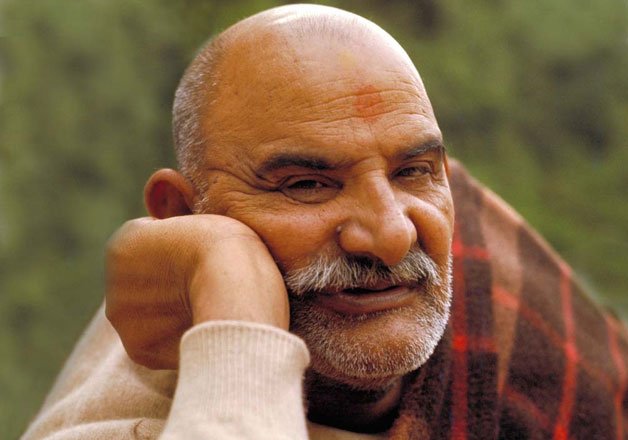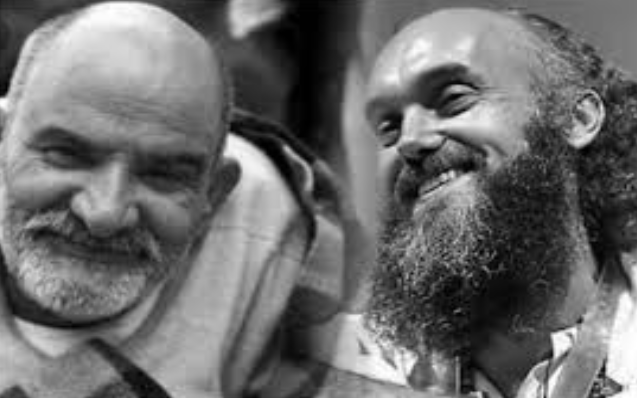Neem Karoli Baba, named as Lakshman Das at his birth, was from Uttar Pradesh in India. Born around 1900 in Akbarpur village, he belonged to a wealthy Brahmin family.
Due to the child-marriage customs prevailing in India during that time, his parents married him at an early age of 11. He then left his home to become a sadhu (hermit). Due to frequent requests by his father, he returned home and settled into his married life and later had two sons and a daughter.
Neem Karoli Baba, reverently known as “Maharaj ji” by his devotees and disciples, believed in the concept of All is One. He often said “Sub Ek” (All is one) and conceptualized the motto of “Love.Serve.Remember.”
With this, he taught his followers to love and serve everyone, and to remember God always.
“Total truth is necessary. You must live by what you say.”
He always emphasized on speaking the truth. No matter what, one must stand on one’s own words, and follow the righteous path.

All is One:
Baba always used to say “Sub Ek”- All is one. His words of wisdom supported this belief of his.
“See all the same.”
“The whole universe is our home and all residing in it belong to our family… instead of trying to see God in a particular appearance, it is better to see him in everything.”
Maharaj ji’s teachings were simple, practical and universal.
“All religions are the same. They all lead to God. God is everybody … The same blood flows through us all, the arms, the legs, the heart, all are the same. See no difference.
Neem Karoli Baba was a great unifier. He always considered every human as equal; equal in religion, caste, creed or any other aspect. He taught us to search and see God in every being around us. Following this doctrine would help us to respect every individual no matter who they are!
Chamatkari (Miracle) Baba:
Maharaj ji was popularly known as “Miracle Baba” in the northern region of India. It is believed that he possessed siddhis (powers) like putting devotees in samadhi (a state of intense concentration achieved through meditation) by his mere finger touch. He even had the knowledge of duality; being in two places at the same time!
A few incidences of his miracles are as mentioned below:
Maharajji and the Smallpox—
Dada’s nephew was unwell with smallpox, and apparently his death was very near; the body had been moved to the floor from the bed. Someone suggested that “Ganga jal” with which Baba’s feet have been washed, to be put in the boy’s mouth. This actually worked as a miracle, and the boy got completely cured the very next day.
But at the same time, miles away in the hills, suddenly these spots emerged all over Maharajji’s body. People on the hills were unaware of smallpox, as it was a rare occurrence in those regions. Hence they applied some lotion and treated it, assuming it to be some kind of allergy. Next day he became well too. Much later it was found out that the boy’s cure from smallpox and the Maharajji’s spots coincided.
One Problem, Different Treatments!
One day a sadhu named Balak came and greeted Maharaj, while he was sitting near a roadside place. Balak told Maharaj that he had a severe stomach ache since last evening. Baba gave him some water from a metal pot he had, and told him to drink and run around. In just a little time, to his amazement, the pain disappeared.
The very day, Pandit Mama also came to Maharajji with the same complaint of stomach ache. Baba advised him to get admitted to a hospital in Nainital; he also sent his followers to check on his health improvement throughout the day. Later Baba was questioned by an observer, the reason to provide two different treatments for the same problem!
Maharaj said, “ God takes care of those who have no one to take care of; incase of Pandit, he is a well to do man. He wants good treatment and expects people to sympathise with him.”
How “Neem Karoli Baba” got his name—the Story:
Once when Baba Lakshman Dass (as he was known then) was in his late twenties, he was travelling in a train to a nearby city. He had no food for several days, when he had to board for another place. The conductor found Maharaj ji sitting in the first class coach without a ticket; making him pull the emergency brake to stop the train. After a few moments of argument and verbal discourse, Maharaj ji was put off the train. The train was halted near the village of “Neeb Karori” where he had been living.
Baba sat under the shade of a tree nearby. The driver started the train engine, as soon as the conductor blew the whistle. But to their disappointment, the train didn’t move. They tried several ways to get the engine going, but to vain. Even a new engine from the next station was called for, but it didn’t help the train to move as well.
A local passenger from that village knew about Maharaj ji, and suggested the officials request Baba to get on the train. Considering all this as superstition, they did not pay any heed to this advice; but after all failed efforts, they were forced to bow in front of Maharaj ji.
On repeated requests and offerings of food and sweets, Maharaj ji agreed to board the train. But he made two conditions for doing so:
1. The officials had to promise to build a new station at “Neeb Karori”; as villagers had to walk miles to get to the nearest station
2. The railroad was to treat Sadhus (saints) with respect.
After the railway officials promised to do their best in fulfilling his demands, Baba then re boarded the train. After the train travelled a few miles, the engineer stopped it again, and said that he’ll only continue to drive, if the sadhu blesses him. When Baba told him to continue, he then proceeded with the remaining journey.
Maharaj ji narrated it later that the officials kept their word, and built a station for the Neeb Karori village. Also they were polite and showed respect to all sadhus thereafter.
Hanuman Bhakt (devotee):
Once she finished hearing Yajnavyalka’s discourse on the soul and the way to attaining immortality, Maitreyi set forth on the path to finding eternal bliss. She liberated herself from the endless cycles of birth and death by gaining a deep understanding of spiritual knowledge and attained Moksha or immortality.
Maitreyi is an icon for the present generation of women to follow as an ideal. She showed that it is important to be acquainted with self or Atma and love it, in order to be loved by others.
She also showed by example how women can achieve the heights of knowledge; simply by listening to and following and practicing the path shown in the Vedas.
Baba And His Disciple:
Baba influenced and enlightened many lives with his sermons and thoughts. Out of the many disciples he made, Ram Das is one of the most revered one.
Richard Alpert was popularly known as Baba Ram Dass. He was an American spiritual teacher, psychologist, and author. His most famous book, “Be Here Now” (1971) helped to promote Eastern spirituality and yoga in the West. It has been described as “seminal” and very influential.

In 1967, when Alpert traveled to India and became a disciple of Neem Karoli Baba, he was conferred with the name Ram Dass, meaning “Servant of Ram” by Baba himself. In the later years, he formed the charitable organizations “Seva Foundation” and “Hanuman Foundation” and traveled extensively for decades (1970s, 1980s, 1990s) for fundraiser activities and other charitable causes.
Due to a stroke, in 1997, he got paralysed and suffered from expressive aphasia. But he took this mishap as an act of grace, eventually learning to speak and continuing to teach and write books. During a visit to India in 2004, he fell seriously ill. This led him to give up on travelling and he moved to Hawaii. Here he served in annual retreats with other spiritual teachers until he breathed his last.
God is in Everything:
“Even if a person hurts you, give him love. The worst punishment is to throw someone out of your heart… You should love everyone as God, and love each other. If you cannot love each other, you cannot achieve your goal.”
He always stressed on loving each other, every fellow being inspired by any bitter experience with him. He believed this was the best way to love God.
“If you want to see God, kill desires. Desires are in the mind. When you have a desire for something, don’t act on it and it will go away. If you desire to drink this cup of tea, don’t, and the desire for it will go away.”
He gave a simple formula for finding God—to kill all desires. Desires were simply manifestations of our mind, he would believe. Hence he always advised us to ignore the temptation, to let the desire go away from our mind.
He followed a non-traditional way of teaching his followers and disciples; with personalised approach to the individual’s problems and queries. He did not give long discourses, his teachings were in simple, brief stories interspersed with laughter and jokes.
Yet his modest Indian Ashram in the USA attracts tech Titans like Zuckerberg and Jobs, Larry Page and Jeffrey Skoll of eBay.
The Remembrance Continues:
The great Indian sadhu, Neem Karoli Maharaj from the Himalayan lineage left his body in 1973. In his respect, over 100 temples were constructed in his name.
His ashrams are in Kainchi, Vrindavan, Rishikesh, Shimla, Neem Karoli village, Bhumiyadhar, Hanumangarhi, Delhi in India and in Taos, New Mexico, Germany and the US.
Outside India, known for being the spiritual master of a number of Americans who travelled to India in the 1960s and 70s, the most popular being the spiritual teachers Ram Dass and Bhagavan Das, and the musicians Krishna Das and Jai Uttal.
His disciples remember him for the unconditional love showered on everyone he met. People who were lucky to meet him became his followers; even many who haven’t met him physically established a connection with him through his teachings.
Neem Karoli Baba was a ‘Sidhha Purusha’, a knower of the past, present and future, a Trikala Jnani.
Interested in becoming a yoga teacher?
Newsletter
Upcoming events and latest blogs